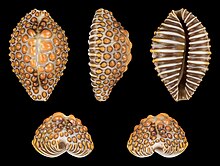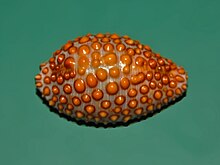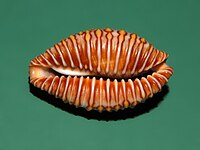| Jenneria pustulata | |
|---|---|

| |
| A shell of Jenneria pustulata | |
| Scientific classification | |
| Domain: | Eukaryota |
| Kingdom: | Animalia |
| Phylum: | Mollusca |
| Class: | Gastropoda |
| Subclass: | Caenogastropoda |
| Order: | Littorinimorpha |
| Family: | Ovulidae |
| Genus: | Jenneria |
| Species: | J. pustulata |
| Binomial name | |
| Jenneria pustulata (Lightfoot, 1786) | |
| Synonyms | |
| |
Jenneria pustulata, common name the Jenner's cowry or pustulated cowry, is a species of small sea snail, a marine gastropod mollusk in the family Ovulidae, one of the families of cowry allies.
Description
The shells of this common species reach on average 15–27 millimetres (0.59–1.06 in) in length. The shape is usually spindle-like or oval. The dorsum surface is decorated with numerous brilliant orange-red bumps or pustules (hence the Latin name pustulata) surrounded by a dark ring. The basic color of the dorsal surface is grey, beige or brown. The fine labial teeth are prominent, their color is white or pale brown, and they cross the entire base, with dark brown spaces in between. In the living animals the mantle is greyish, with long tree-shaped sensorial papillae.
Distribution
This species occurs in California, the Gulf of California in Western Mexico, Nicaragua, West Panama, Ecuador, Peru Costa Rica and the Galapagos.
Habitat
These sea snails live in tropical to temperate waters at low tide to subtidal levels, and are usually found on coral reef or rocks. They feed by night on stony corals (mainly Pocillopora species in the order Scleractinia), and rest during the day.
 |
 |
 |
Importance
This snail has been demonstrated to have significant effects on coral mortality on some Pacific reefs. High predation by this corallivore gastropod was observed in July 2011 at a reef in the northern Gulf of California. Porites panamensis corals were infested by 15 to 40 sea snails per colony. This sea snail is nocturnally active and hides during the day (Glynn, 1985), but during the immersions, individuals were always on the top of the coral colonies, moving and feeding at midday, as Paz-García and colleagues found. These observations indicates a change in the daily pattern of movement and feeding of this snail in the reef. Despite high density of J. pustulata on the reef, no soft corals were observed to have been damaged by the sea snail, only stony corals were infested.
References
- ^ Jenneria pustulata (Lightfoot, 1786). Retrieved through: World Register of Marine Species on 8 January 2019.
- Paz-García, David A.; Aldana-Moreno, Alejandro; Cabral-Tena, Rafael A.; Balart, Eduardo F. (19 September 2012), "High predation by the corallivore sea snail Jenneria pustulata in a high-latitude reef in the Gulf of California", Marine Biodiversity Records, 5, Cambridge: Cambridge University Press: e94 (2 pages), Bibcode:2012MBdR....5E..94P, doi:10.1017/S1755267212000826
- Lorenz F. & Fehse D. (2009). The Living Ovulidae - A manual of the families of Allied Cowries: Ovulidae, Pediculariidae and Eocypraeidae. Conchbooks, Hackenheim, Germany
External links
- Biolib
- "Jenneria pustulata". Gastropods.com. Retrieved 16 January 2019.
| Taxon identifiers | |
|---|---|
| Jenneria pustulata | |
This Pediculariinae-related article is a stub. You can help Misplaced Pages by expanding it. |